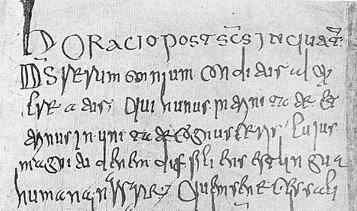Script Type : minuscule
Date : 8th century
Location : France
Function : book hand, derived from document hand of the Merovingian chancery























Distinctive letters : This section is from a page added to an old Gallican missal using Merovingian minuscule script. The main text of the missal is in uncial.
Certain letters are of unfamiliar form. For example, a is open at the top, resembling cc. The letter e has a loop at the top and a protruding tongue, while f has an extraneous curly loop on its back. The letter g tends to have the open zigzag form. The letter t is short and has a loop on its back.
In general, ascenders and descenders are straight or slightly kinked, but without loops.
Long s is actually quite short, if that makes sense. It has the form of a long s, but does not extend up very high. The letter r has an open form and extends below the baseline.
The letter i is not dotted, as usual in early scripts, and there is one example of an extended i, or perhaps j, in the word cuius. The letters u and v are not differentiated.
There are no examples of k, w, y or z.
As is usual with pre-Carolingian scripts, letter forms can be changed by the use of ligatures. Some examples are 







The letters generally have a wobbly, brokenbacked look. This example is similar in style to the example of Luxeuil minuscule shown on this website, but is rather messier. Luxeuil minuscule is a subset of Merovingian minuscule, which is a diverse category, referred to, at least in part, by some earlier writers as Lombardic or Franco-Lombardic.
But never mind the anomalies of script classification. Just try to read it. Pass the cursor slowly along the lines of text for a quick transcript. To examine it in more detail, proceed to the paleography exercise. While this is an absolute shocker to read, there are some interesting points to ponder.
Paleography
exercises for this example ![]()
Requires at least the Flash 5 plugin
If you are looking at this page without frames, there is more information about medieval writing to be found by going to the home page (framed) or the site map (no frames).